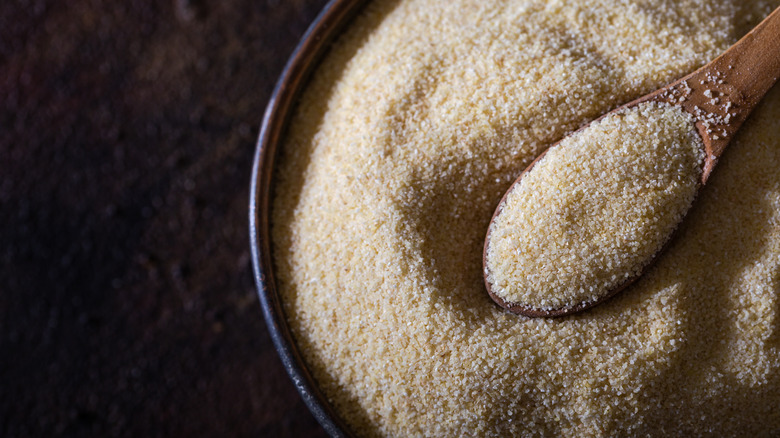Semolina Is The Ingredient That Will Give Your Pizza That Desired Crunch
Making pizza at home can be a truly rewarding experience. Every part of the process sparks joy: from making your own sourdough pizza dough to sourcing the best canned San Marzano tomatoes for your sauce to watching as the dough puffs up into a gloriously pillowy crust. But what a disappointment when you pull the pizza out and the crust is floury, pale, and decidedly un-crunchy. It's not you, it's your oven. Homemade pizza doesn't get as crunchy as it does at your favorite Neapolitan place because our ovens just don't get hot enough. The oven in your kitchen probably tops out at 500 degrees Fahrenheit, while a wood-fired pizza oven can easily reach temperatures of up to 1000 degrees. This heat is what crisps up the pizza crust. But we can achieve crunchy crusts at home with semolina flour.
Semolina flour, made from durum wheat, is more coarse than regular flour – it'll feel like small sand granules when you rub it between your fingers. It can withstand the high temperatures of a pizza oven meaning it won't burn like other flours, so it'll give your crust a crunchy texture without the bitterness of burnt flour. Using your favorite pizza dough, sprinkle your work surface with semolina — a light dusting is all you need, if you use too much your pizza will be grainy. As a bonus, semolina flour is also useful for getting the pizza onto the peel without sticking during transfer into the oven.
Getting great pizza at home is easier than you think
Semolina flour works well to give your pizza extra crunch if you sprinkle it on your work surface before baking, but some recipes incorporate it into the dough itself. Semolina flour is usually found in Italian fresh pasta recipes due to its high gluten content – there are around 21 grams of protein in a cup of semolina flour, according to the USDA. The high protein content means that it's also the perfect candidate to add to pizza dough. Add some semolina flour to your 00 pizza flour to achieve a crisp exterior and a nice, bouncy chew on your pizza crust. Leite's Culinaria recommends using mostly semolina flour, while King Arthur Baking recommends the opposite, but with only a slightly less semolina-flour-to-00-flour ratio. Besides adding some much-needed crunch to your homemade pizza, semolina flour will also add a hint of earthy nuttiness when it gets toasted, especially if you're using a pizza stone or steel.
Semolina flour is also ideal for more bready pizzas, like a Sicilian pizza, called sfincione, or a focaccia pizza crust. The higher gluten content of semolina makes the crust chewy and springy, and the nuttiness and earthiness come through, as well. The dough is sturdy enough to hold up in the oven, becoming crisp and toothsome with layers of sauce and cheese spread across the top.

